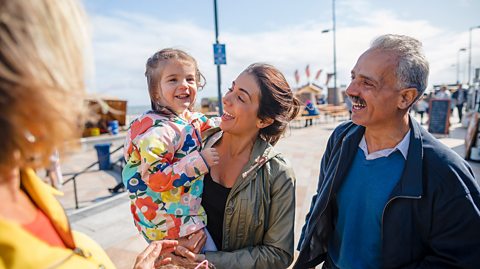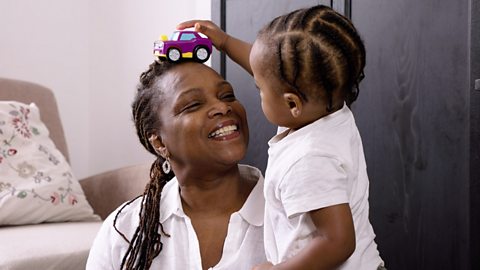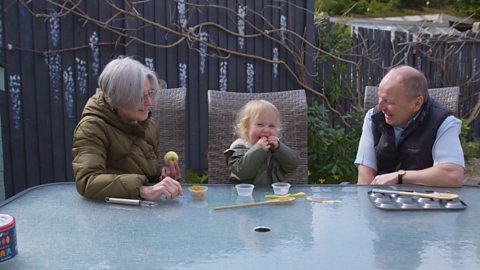Home > Play > Grandparents
Young children are often full of energy, and it can sometimes feel impossible to get them to sit still for more than a few seconds.
This can be challenging if you’re a parent, grandparent or carer with a disability or limited mobility. It may be harder to play on the floor, move around a lot or enjoy sporty games.
But there’s no need to let mobility issues limit the fun.
We’ve put together a list of activities for young children that are gentle on your body but still loads of fun and great for language development.
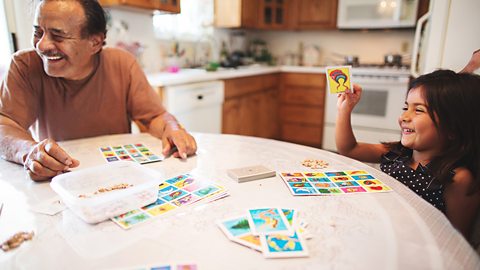
How does playing at a table benefit toddlers and preschoolers?
“Tabletop activities are one way to help everyone join in the fun,” says Alys Mathers, a specialist speech and language therapist.
“If you’ve got a family member that is less mobile, tabletop activities allow them to still be a key part of that child’s development.”
Babies and toddlers are constantly building up their core strength, which allows them to roll over, sit upright, walk, and more. Playing at a table while sitting in a chair targets these core muscles and helps their posture and strength.
Tabletop activities are also great for building focus and preparing a child for when they start school.
“Just sitting and colouring at a table helps children to practise focussing on one activity for slightly longer, rather than moving between lots of different activities,” explains Alys.
It allows them to experience a sense of discipline and routine that they will experience at school and can help extend their attention span.
Toddlers and younger children will find it difficult to sit and concentrate on one thing for longer periods.
“A few minutes of concentrated play at a time is enough for very little children,” says Alys. “It can feel like a long time for them.”
If your child struggles to stay concentrated, Alys recommends keeping games at the table really short initially.
Perhaps you only colour in one small part of a picture or read a few pages of a book. This will allow your child to feel a sense of accomplishment before they go off and do a different activity.
The more you play with them at the table, the longer these periods of concentration will become.
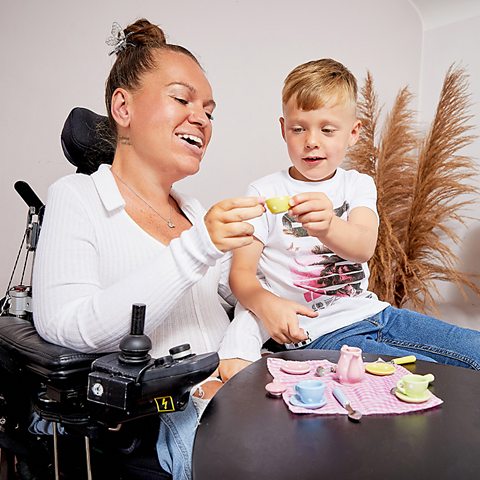
Tabletop activities don’t have to be boring
When you’re thinking about what tabletop activities to try with your child or grandchild, try to be creative.
Being at a table does not limit you to just reading books, painting and drawing. While these activities are classics and great for young children, there are many more games that can be adapted to work for you.
“You don’t need to think that tables are only for the more formal learning activities,” says Alys.
Why not try bringing a bowl of water or some jelly to the table for some sensory fun? Or consider bringing floor games up to your level - this could be playing with toy cars or having a teddy bear’s picnic.
“Not thinking of a table and chair as limiting or restricting your play is really important,” explains Alys.
“Just because you and your child or grandchild are sitting down together, it doesn’t mean they can’t get up and do some actions or find an object.”
Kids will always want and need to move around, and that’s fine. There are ways you can work this into your play.
Games such as vegetable hide and seek, warmer and colder, and packing a bag give children a chance to walk around and explore objects in the room while they play. This is also a great opportunity to introduce lots of descriptive language into the conversation.
No matter what activity you choose, the most important thing is to follow your child’s lead and talk to them about what takes their interest.

How to set up tabletop activities
“One of the key things with tabletop play is making sure that the setup is right in the first place,” says Alys.
At this age, children’s muscles are still developing, especially their core. It’s normal for them to be a bit wobbly when balancing and sitting up.
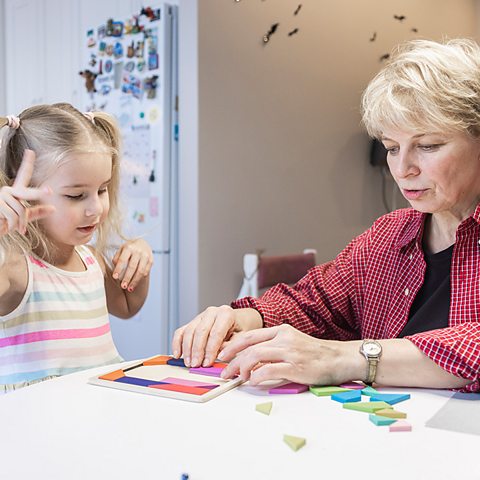
Prepare the right setup
“Children sometimes need a little bit more to feel secure than we might think,” explains Alys, who recommends considering whether your child needs a booster seat, a high chair, or even just a couple of cushions.
Consider whether they’re sitting at your height and can reach the table comfortably. Can you make adjustments to make them feel more steady in their chair?
Sometimes the smallest changes, like setting children up next to a wall, or giving them a seat with arms, can really help them stay focused that little bit longer.
“If the setup is not right, they’re not going to really enjoy the activity or settle on it. They might be fidgety or worry about not feeling secure.”
Think about posture
“If your child is dangling their legs, this could be a sign that they’re not feeling that secure or stable,” says Alys. “Providing something like a box that they can put their feet on will make them feel grounded.”
Getting the right setup and making your child comfortable improves their attention span and helps them focus on whatever activity you are playing.
“Another thing I like to think about when I’m setting up activities is are we sitting side-by-side, at a corner, or opposite each other?”
“Some children prefer to be side-by-side because it’s a bit less intense,” says Alys. But if you’re playing a game, you might want that back-and-forth that comes from sitting face-to-face.
Let them take the lead
There are so many different tabletop games to choose from but it’s important to let your little one take the lead.
Let them choose which activity they would like to play by giving them some options and keep adapting your play to what takes their interest.
This might mean that your activity looks a bit different to some of the ones on our website, but that’s alright! As long as you’re talking to and engaging with your child, they will be having lots of fun and learning as they go.

Tabletop activities for toddlers 12 months+
1. Clapping games
Clapping along to rhymes helps children pick up rhythms, which also helps them pay attention to language too.
2. Reading a book
Snuggling up and sharing a book is a classic low mobility activity. Your child is never too young to start exploring stories.
3. Tap tap box
Fill a box with everyday items from your home that you and your child can talk about. Don’t forget the element of surprise!
4. Pairing socks
Describe the different colours, patterns, and textures as you spend some time pairing socks.
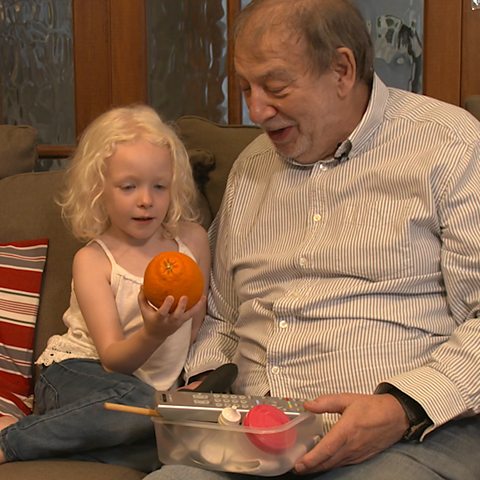
Tabletop activities for preschoolers 3 years+
1. Putting things in order
Send your child around the room to find lots of items of different sizes. Can they put them in order?
2. Drawing together
This classic drawing activity boosts creativity, helps with fine motor skills and is a great way to help your child prepare for school.
3. Making a puzzle
Making a puzzle together is a fun way to help develop your child's concentration and coordination skills.
4. Memory games
A fun memory game using only items from around your house and a tea towel. Allow your child to pick up items from around the house before you start to play.
Getting messy at the table activities
1. Finger painting
Finger painting is a great sensory activity for toddlers. They'll love playing with the paints and getting messy with you.
2. Homemade playdough
Get sticky with our homemade playdough recipe. You can make it from everyday ingredients found in your kitchen cupboards.
3. Painting with teabags
Painting with cold teabags is a fun way to boost your child's imagination. Ask them to describe what they are painting.

4. Cooking with children
Cooking together is a great way to bond with your child, have fun and chat with them.

